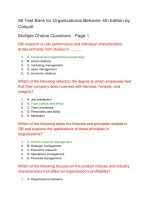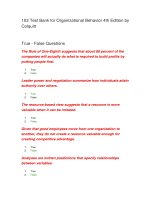Organizational behavior 4th by MShean chap013
Bạn đang xem bản rút gọn của tài liệu. Xem và tải ngay bản đầy đủ của tài liệu tại đây (388.14 KB, 23 trang )
13
Conflict and Negotiation
in the Workplace
McGraw-Hill/Irwin
© 2008 The McGraw-Hill Companies, Inc. All rights reserved.
Conflict at Microsoft
• Various sources conclude that
Microsoft is riddled with
dysfunctional conflict that could
soon hamper its ability to remain
competitive.
• “Pretty much across the board
people are saying that Microsoft
is dysfunctional,” concludes one
industry analyst. “They are not
cooperating across business
groups.”
McShane/Von Glinow OB4e
Slide 13-2
© 2008 The McGraw-Hill Companies, Inc. All rights reserved.
Conflict Defined
The process in which
one party perceives that
its interests are being
opposed or negatively
affected by another
party.
McShane/Von Glinow OB4e
Slide 13-3
© 2008 The McGraw-Hill Companies, Inc. All rights reserved.
The Conflict Process
Conflict
Perceptions
Sources of
Conflict
Manifest
Conflict
Conflict
Outcomes
Conflict
Emotions
Conflict
Escalation Cycle
McShane/Von Glinow OB4e
Slide 13-4
© 2008 The McGraw-Hill Companies, Inc. All rights reserved.
Organizational Conflict Outcomes
• Potential benefits
– Improves decision making
– Strengthens team dynamics
• Dysfunctional outcomes
– Diverts energy and resources
– Weakens knowledge management
– Increases frustration, job dissatisfaction,
stress, turnover and absenteeism
McShane/Von Glinow OB4e
Slide 13-5
© 2008 The McGraw-Hill Companies, Inc. All rights reserved.
Task vs. Socioemotional Conflict
• Constructive (task-related) conflict
– Conflict is aimed at issue, not parties
– Helps recognize problems, identify solutions, and
understand the issues better
– Potentially healthy and valuable
• Socioemotional (relationship) conflict
– Conflict viewed as a personal attack
– Introduces perceptual biases
– Distorts information processing
McShane/Von Glinow OB4e
Slide 13-6
© 2008 The McGraw-Hill Companies, Inc. All rights reserved.
Minimizing Socioemotional Conflict
1. Emotional intelligence
– Better able to regulate emotions
– View others’ emotions as information
2. Cohesive team
– More trust and latitude
– Understand other team members better
– Motivated to minimize escalating conflict
3. Supportive team norms
– Appreciate honest dialogue without personal affront
– Some norms might discourage displaying negative emotions
McShane/Von Glinow OB4e
Slide 13-7
© 2008 The McGraw-Hill Companies, Inc. All rights reserved.
Sources of Conflict
Incompatible
Goals
• One party’s goals perceived to
interfere with other’s goals
Differentiation
• Different values/beliefs
• Explains cross-cultural and
generational conflict
Task
Interdependence
• Conflict increases with
interdependence
• Higher risk that parties interfere with
each other
more
McShane/Von Glinow OB4e
Slide 13-8
© 2008 The McGraw-Hill Companies, Inc. All rights reserved.
Sources of Conflict (con’t)
Scarce
Resources
• Motivates competition for the resource
Ambiguous Rules
• Creates uncertainty, threatens goals
• Without rules, people rely on politics
Communication
Problems
• Increases stereotyping
• Reduces motivation to communicate
• Escalates conflict when arrogant
McShane/Von Glinow OB4e
Slide 13-9
© 2008 The McGraw-Hill Companies, Inc. All rights reserved.
NHLPA Changes Conflict Styles
Outgoing National Hockey League
Players’ Association (NHLPA) boss
Bob Goodenow (left) was called
the Darth Vader of hockey,
because of his forcing style of
conflict management with NHL
owners. Taking his place is Ted
Saskin (right), whose diplomatic
problem-solving conflict resolution
style couldn’t be more different
from Goodenow’s.
McShane/Von Glinow OB4e
Slide 13-10
© 2008 The McGraw-Hill Companies, Inc. All rights reserved.
Conflict Management Styles
Forcing
Assertiveness
High
Problem-Solving
Compromising
Avoiding
Low
McShane/Von Glinow OB4e
Yielding
Cooperativeness
Slide 13-11
High
© 2008 The McGraw-Hill Companies, Inc. All rights reserved.
Choosing the Best Conflict Style
•
Problem solving
– Often best because only style that seeks an optimal outcome
– Doesn’t work when interests perfectly opposing
– Difficult when parties lack trust/openness
•
Avoiding
– Best when socioemotional conflict is high
– Problem: doesn’t resolve conflict source, so may produce longterm frustration
•
Yielding
– May be necessary when:
1. the other party has substantially more power
2. the issue is less important to you as to the other party
– Problem: Other party develops higher future expectations
McShane/Von Glinow OB4e
Slide 13-12
© 2008 The McGraw-Hill Companies, Inc. All rights reserved.
Choosing the Best Conflict Style
•
(con’t)
Forcing
– May be necessary when:
1. you know you are correct & dispute requires quick solution
2. the other party would take advantage of more cooperative
strategies
– Problem: Fuels socioemotional conflict
•
Compromising
– Best when
1. little hope for mutual gain
2. both parties have equal power
3. both parties need to settle differences quickly
– Problem: “Good enough” solution that overlooks better
solutions
McShane/Von Glinow OB4e
Slide 13-13
© 2008 The McGraw-Hill Companies, Inc. All rights reserved.
Emphasizing Superordinate Goals
• Emphasizing common objectives rather than
conflicting sub-goals
• Reduces goal incompatibility and
differentiation
McShane/Von Glinow OB4e
Slide 13-14
© 2008 The McGraw-Hill Companies, Inc. All rights reserved.
Toyota Drums Out Differences
Employees at Toyota Motor Sales
U.S.A. are drumming out their
differences in the car company’s
drum room. Typically in groups of 15
to 50 from one department,
employees bang on various
percussion instruments. Most
groups soon find a common beat
without any guidance or conductor.
Edward Carreon/Newhouse News Service
McShane/Von Glinow OB4e
Slide 13-15
© 2008 The McGraw-Hill Companies, Inc. All rights reserved.
Reducing Differentiation
• Remove sources of different
values and beliefs
• Move employees around to
different jobs, departments,
and regions
• Other ways to reduce
differentiation:
–Common dress code/status
–Common work experiences
Edward Carreon/Newhouse News Service
McShane/Von Glinow OB4e
Slide 13-16
© 2008 The McGraw-Hill Companies, Inc. All rights reserved.
Better Communication/Understanding
• Employees understand and appreciate each
other’s views through communication
– Relates to contact hypothesis
• Two warnings:
1.Apply communication/understanding after reducing
differentiation
2.A Western strategy that may conflict with
values/traditions in other cultures
McShane/Von Glinow OB4e
Slide 13-17
© 2008 The McGraw-Hill Companies, Inc. All rights reserved.
Other Ways to Manage Conflict
• Reduce Task Interdependence
– Dividing shared resources
– Combine tasks
– Use buffers
• Increase Resources
– Duplicate resources
• Clarify Rules and Procedures
– Clarify resource distribution
– Change interdependence
McShane/Von Glinow OB4e
Slide 13-18
© 2008 The McGraw-Hill Companies, Inc. All rights reserved.
Bargaining Zone Model
Your Positions
Initial
Target
Resistance
Area of
Potential
Agreement
Resistance
Target
Initial
Opponent’s Positions
McShane/Von Glinow OB4e
Slide 13-19
© 2008 The McGraw-Hill Companies, Inc. All rights reserved.
Situational Influences on Negotiation
• Location
• Physical setting
• Time passage and
deadlines
• Audience
© Corel Corp. With permission.
McShane/Von Glinow OB4e
Slide 13-20
© 2008 The McGraw-Hill Companies, Inc. All rights reserved.
Effective Negotiation Behavior
• Preparation and goal
setting
• Gathering information
• Communicating
effectively
© Corel Corp. With permission.
McShane/Von Glinow OB4e
• Making concessions
Slide 13-21
© 2008 The McGraw-Hill Companies, Inc. All rights reserved.
Types of Third Party Intervention
High
Mediation
Inquisition
Level of
Process
Control
Arbitration
Low
McShane/Von Glinow OB4e
Level of Outcome Control
Slide 13-22
High
© 2008 The McGraw-Hill Companies, Inc. All rights reserved.
13
Conflict and Negotiation
in the Workplace
McGraw-Hill/Irwin
© 2008 The McGraw-Hill Companies, Inc. All rights reserved.









